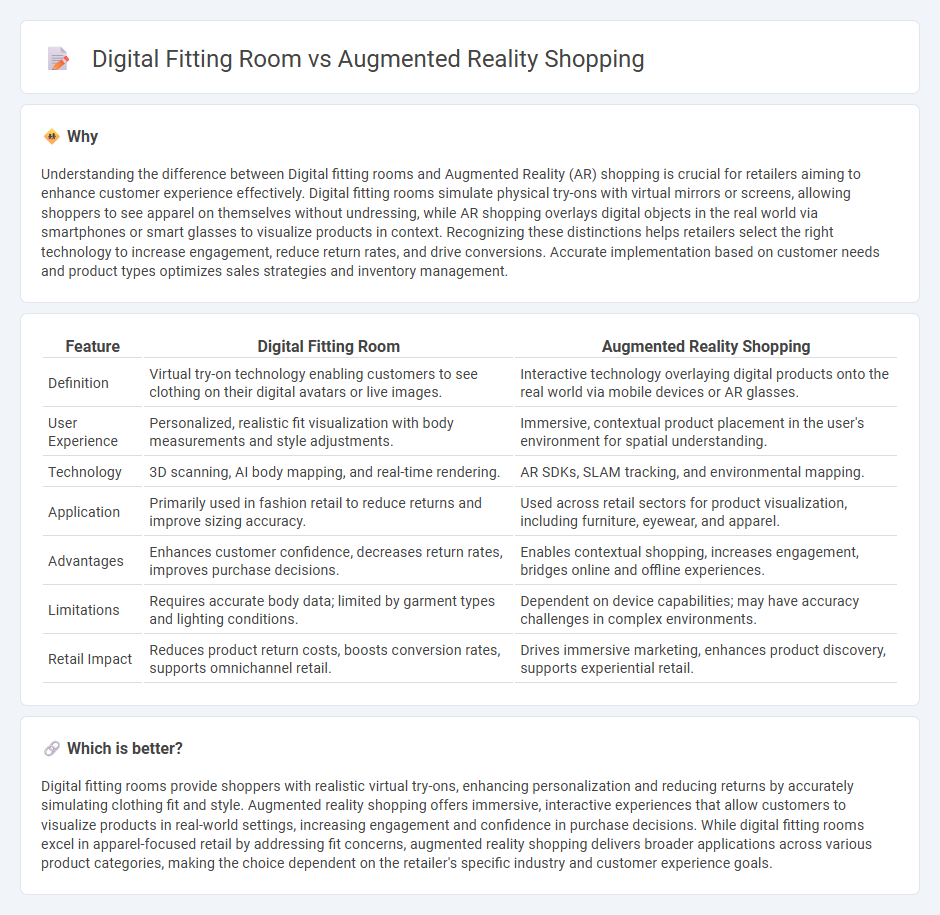
Digital fitting rooms enhance the retail experience by allowing customers to virtually try on clothes using advanced body-mapping technology, reducing the need for physical trials and minimizing return rates. Augmented reality shopping integrates digital overlays with real-world environments, enabling shoppers to visualize products such as apparel or accessories in real time via smartphones or smart mirrors. Explore how these innovative technologies are transforming retail shopping and customer engagement.
Why it is important
Understanding the difference between Digital fitting rooms and Augmented Reality (AR) shopping is crucial for retailers aiming to enhance customer experience effectively. Digital fitting rooms simulate physical try-ons with virtual mirrors or screens, allowing shoppers to see apparel on themselves without undressing, while AR shopping overlays digital objects in the real world via smartphones or smart glasses to visualize products in context. Recognizing these distinctions helps retailers select the right technology to increase engagement, reduce return rates, and drive conversions. Accurate implementation based on customer needs and product types optimizes sales strategies and inventory management.
Comparison Table
| Feature | Digital Fitting Room | Augmented Reality Shopping |
|---|---|---|
| Definition | Virtual try-on technology enabling customers to see clothing on their digital avatars or live images. | Interactive technology overlaying digital products onto the real world via mobile devices or AR glasses. |
| User Experience | Personalized, realistic fit visualization with body measurements and style adjustments. | Immersive, contextual product placement in the user's environment for spatial understanding. |
| Technology | 3D scanning, AI body mapping, and real-time rendering. | AR SDKs, SLAM tracking, and environmental mapping. |
| Application | Primarily used in fashion retail to reduce returns and improve sizing accuracy. | Used across retail sectors for product visualization, including furniture, eyewear, and apparel. |
| Advantages | Enhances customer confidence, decreases return rates, improves purchase decisions. | Enables contextual shopping, increases engagement, bridges online and offline experiences. |
| Limitations | Requires accurate body data; limited by garment types and lighting conditions. | Dependent on device capabilities; may have accuracy challenges in complex environments. |
| Retail Impact | Reduces product return costs, boosts conversion rates, supports omnichannel retail. | Drives immersive marketing, enhances product discovery, supports experiential retail. |
Which is better?
Digital fitting rooms provide shoppers with realistic virtual try-ons, enhancing personalization and reducing returns by accurately simulating clothing fit and style. Augmented reality shopping offers immersive, interactive experiences that allow customers to visualize products in real-world settings, increasing engagement and confidence in purchase decisions. While digital fitting rooms excel in apparel-focused retail by addressing fit concerns, augmented reality shopping delivers broader applications across various product categories, making the choice dependent on the retailer's specific industry and customer experience goals.
Connection
Digital fitting rooms and augmented reality (AR) shopping enhance the retail experience by allowing customers to virtually try on clothes and accessories using advanced imaging technology. Both technologies utilize AR to create a realistic representation of products on a shopper's body, reducing the need for physical trials and minimizing return rates. Retailers adopting these innovations benefit from improved customer engagement, personalized shopping experiences, and increased conversion rates.
Key Terms
Virtual Try-On
Augmented reality shopping enables consumers to visualize products in real-world environments using smartphone cameras, enhancing engagement and purchase confidence. Digital fitting rooms offer virtual try-on technology specifically for apparel and accessories, allowing users to see how items fit and look without physical trials. Explore the latest advancements in virtual try-on solutions to transform your retail experience.
3D Visualization
Augmented reality shopping enhances the retail experience by allowing customers to interact with 3D visualizations of products in their real environment, providing a more immersive and accurate representation than static images. Digital fitting rooms utilize advanced 3D visualization technology to simulate how clothing items fit and look on a user's body, helping to reduce return rates and increase customer satisfaction. Explore further to understand how these innovative 3D visualization tools are transforming the future of online retail.
Size Recommendation
Augmented reality shopping enhances the online retail experience by providing interactive 3D visualizations of products within a user's environment, aiding customers in making informed size and fit decisions. Digital fitting rooms use advanced body-scanning technology to generate accurate size recommendations by simulating how garments fit on individual body shapes, reducing return rates and boosting customer satisfaction. Discover how these innovative size recommendation technologies are transforming e-commerce and personalized shopping experiences.
Source and External Links
AR Shopping: Top Trends and Apps for the Future (2024) - Shopify - Augmented reality shopping enables customers to virtually try on or test products using devices like smartphones or VR headsets, enhancing pre-purchase engagement by simulating in-store experiences or product placement at home.
Top 5 Augmented Reality Apps that Created Immersive Shopping Experiences - AR shopping apps allow consumers to visualize products within their real environments, offering immersive "try-before-you-buy" features that improve buying confidence and reduce returns.
AR in Retail: Cool Use Cases & Key Benefits - Zakeke - Retailers like IKEA, Sephora, and ASOS employ AR technology to let customers virtually place furniture, try on makeup via facial recognition, or see apparel on simulated models, providing more personalized and engaging shopping experiences.
 dowidth.com
dowidth.com